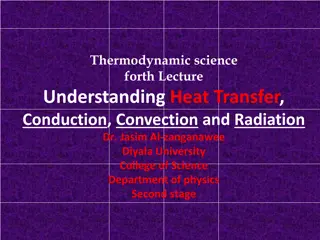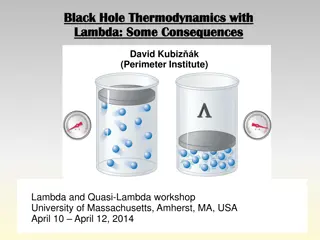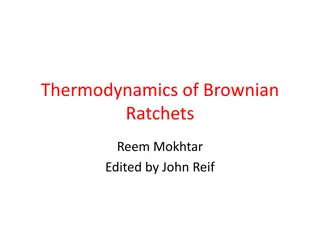Introduction to Chemical Thermodynamics: Systems and Properties
Chemical thermodynamics explores energy changes in chemical reactions. It includes terms like system, surroundings, and boundaries. Systems can be isolated, closed, or open, each with distinct characteristics. Homogeneous and heterogeneous systems have different compositions. Properties in a system can be intensive or extensive.
Download Presentation

Please find below an Image/Link to download the presentation.
The content on the website is provided AS IS for your information and personal use only. It may not be sold, licensed, or shared on other websites without obtaining consent from the author. Download presentation by click this link. If you encounter any issues during the download, it is possible that the publisher has removed the file from their server.
E N D
Presentation Transcript
CHEMICAL THERMODYNAMICS NAME OF THE INSTRUCTOR: U.NITHYA M.Sc.,M.Phil.,
CHEMICAL THERMODYNAMICS The word Thermodynamics means study of flow of heat. DEFINATION: The branch of physical chemistry which deals with the energy changes accompanying a chemical reaction.
Terms used in chemical thermodynamics system - A quantity of matter or a region on space chosen for study surroundings- The mass or region outside the system Boundary The real or imaginary surface that separates the system from its surroundings.
Types of systems 1. Isolated system 2. Closed system 3. Open system
Isolated system Isolated system are completely isolated in every way from their environment. They do not exchange heat, work or matter with their environment. An example of an isolated system would be an insulated rigid containers,such as an insulated gas cylinder.
Closed systems Closed systems are able to exchange energy ( heat and work) , but not matter with their environment. A green house is example of a closed system exchanging heat But not work with its environment. Whether a system exchanges heat,work or both is usually thought of as a property of its boundary.
Open system Open system exchanging both energy ( heat and work) and matter with their environment. A boundary allowing matter exchange is called permeable. The ocean would be an example of an open system.
Homogeous system: A homogeous thermodymic system is defined as the one whose chemical composition and physical properties are same all parts of the system. Heterogeous system: A heterogeous system is defined as one consisting of two or more homogeous bodies.
Physical properties of a system 1. Intensive properties or variables Properties whose values donot depend on the material Present in the system. Eg. Temperature,Pressure,Viscosity,Surface tension 2. Extensive properties or variables. properties whose values depend on the amount of the material present in the system. Eg.mass,volume,energy,heat,capacity,entropy
Thermodynamic process cyclic process Reversible process Irreversiible process isothermal process Adiabatic process
Cyclic process: when a system in a given initial state goes through various processes and finally return toits initial state,the system has undergone a cyclic process. Reversible process: It is defined as a process that once having takes place it can be reversed.In doing So it leaves no change in the system or boundary.
Irreversible process: A process that cannot return both the system and surround to their original conditions. Adiabatic process: A thermodynamic process during which heat energy is transferred to or from the system. Eg: usually a fast process like filling a tank
Isothermal process: A thermodynamic process that takes place at a constant temperature. Eg: Usually a slow process like a baloon expanding slowly during the day
state functions: state functions are variables which are determined only by the initial and final states of the system and not by the path followed during the change from initial to the final state. Eg: Internal energy(U), enthalpy(H), entropy (S),free energy (G) Path functions: Path functions are quantities that depend on the path followed during a change. Eg: Heat absorbed (Q), Work done (w).
Concept of heat &Work Heat: Heat is defined as a quantity that flows across the boundary of a system during a change in its state by virtue of a difference in temperature between the system and surroundings and flows from a point of higher temperature to a point of lower temperature
Work: Work is defined as any quantity that flows across the boundary of a system during a change in its state and completely convertible into the lifting of a weight in the surroundings. Work of expansion: work done during the expansion of a gas is called work of expansion. Work of compression: The workdone by the surroundings to compress the gas is known a work of compression.
THANK YOU























